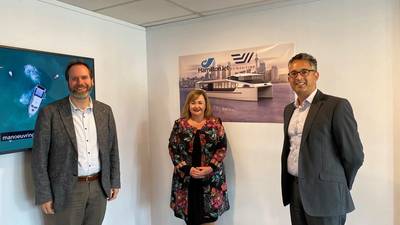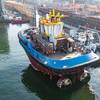NZ Companies Collaborate to Build Electric Ferries
New Zealand companies HamiltonJet and EV Maritime have signed a Memorandum of Understanding to build advanced composite, battery-powered commuter ferries.
Their cooperation was formalized at HamiltonJet’s Christchurch headquarters in May, in the presence of Hon Dr Megan Woods, New Zealand’s Minister of Energy & Resources and Minister of Research Science & Innovation.
With the aim of decarbonizing the harbor cities of the world, the firms are seeking to develop one of the world’s first truly high-speed, full-size, zero emission fast ferries.
HamiltonJet will provide a high efficiency, high maneuverability drive solution for this all-electric vessel, incorporating elements of their new Electro-Hybrid Drive solution, EHX.
EV Maritime CEO Michael Eaglen says, “HamiltonJet is a world leader in marine propulsion systems. Not only for waterjets themselves but for intelligent electronic control systems, which transform vessel maneuverability, improve efficiency, reduce maintenance and enhance passenger comfort,” says Michael Eaglen.
HamiltonJet CEO Ben Reed says, for this project, waterjets bring efficiency, particularly over the whole operational profile. They also offer precise control during docking and the ability to upgrade to automated control technologies in the future. “Our jets are already very popular in high-speed ferries around the world due to their efficiency and maneuverability. This project is a great opportunity, right on our doorstep, to demonstrate how we can tune these aspects for electric-only operation in a ferry with a clearly defined speed range,” he says.
While the electric commuter ferry has been designed with the overhaul of Auckland’s ferry fleet in mind, the two Kiwi companies have much larger ambitions for the project.
“This is an opportunity for New Zealand to claim an important place in the global green transportation sector, with associated sustainable employment and significant long term export potential,” Eaglen says.
He says ferries are also ideal applications for electric technology: “Ferries come and go from the same docks. It means charging infrastructure can be installed at those docks and scheduling can be managed to share charging opportunities around fleets.
“There are plenty of harbor cities around the world with large commuter ferry fleets of 30 or more boats. The vessel we’ve designed is suitable for any of those major cities in terms of the size, speed and range required in most commuter ferry networks.
“Electric power offers huge benefits not only for the environment, but for operators, passengers and the community alike. It’s free of exhaust emissions and offers near-silent operation, while slashing operating costs compared with traditional diesel ferries.
“Our analysis suggests there are very few inshore commuter ferry operations in the world today which need to use diesel. Quite simply, electric is better business already.
“This design also has great potential in the tourism sector. While global tourism will potentially be a lot quieter in the next few years, the need to decarbonize is still very real.”















